There’s something undeniably comforting about a modern farmhouse kitchen that blends warmth with function. If you’ve ever watched Fixer Upper, you’ve seen how Joanna Gaines transformed simple spaces into inviting retreats—proof that rustic charm never goes out of style. Today, this aesthetic continues to win hearts, merging cozy nostalgia with sleek, practical touches.
Designers like Leah Ashley and Laura Hodges have perfected the modern farmhouse kitchen look, proving that a well-designed space can boost your home’s value while reflecting your personality. Think shiplap walls, apron-front sinks, and industrial lighting—details that create character without sacrificing modern convenience.
Whether you’re renovating or just refreshing your space, these ideas offer inspiration for your own modern farmhouse kitchen. Let’s explore how to blend timeless appeal with today’s needs.
Key Takeaways
- Farmhouse style adds warmth and value to your home.
- Mix rustic elements like shiplap with contemporary appliances.
- Designers like Leah Ashley highlight functional yet charming details.
- Vintage lighting and farmhouse sinks are signature features.
- Balance practicality with aesthetics for a cohesive look.
What Defines a Modern Farmhouse Kitchen?
Balancing rustic textures with contemporary finishes creates a space that feels both fresh and timeless. This farmhouse style isn’t about recreating the past—it’s about weaving heritage elements into today’s lifestyles. Think exposed beams paired with smart appliances, or a reclaimed wood table beside matte black fixtures.
Blending Rustic and Contemporary Elements
Designers like Laura Hodges elevate the look by mixing stained wood cabinetry with sleek hardware. Shiplap walls, a hallmark of the design, often share the spotlight with stainless steel refrigerators. Jessica Stambaugh’s use of concrete countertops and milk glass pendants proves even industrial touches can feel warm.
Key Features of the Style
Signature details make this aesthetic stand out. Apron-front sinks contrast with integrated appliances, while rough stone hearths anchor metal bar stools. Erin Napier’s work highlights how raw materials and clean lines coexist effortlessly.
Every choice serves a purpose—beauty and function in harmony.
Essential Elements of a Modern Farmhouse Kitchen
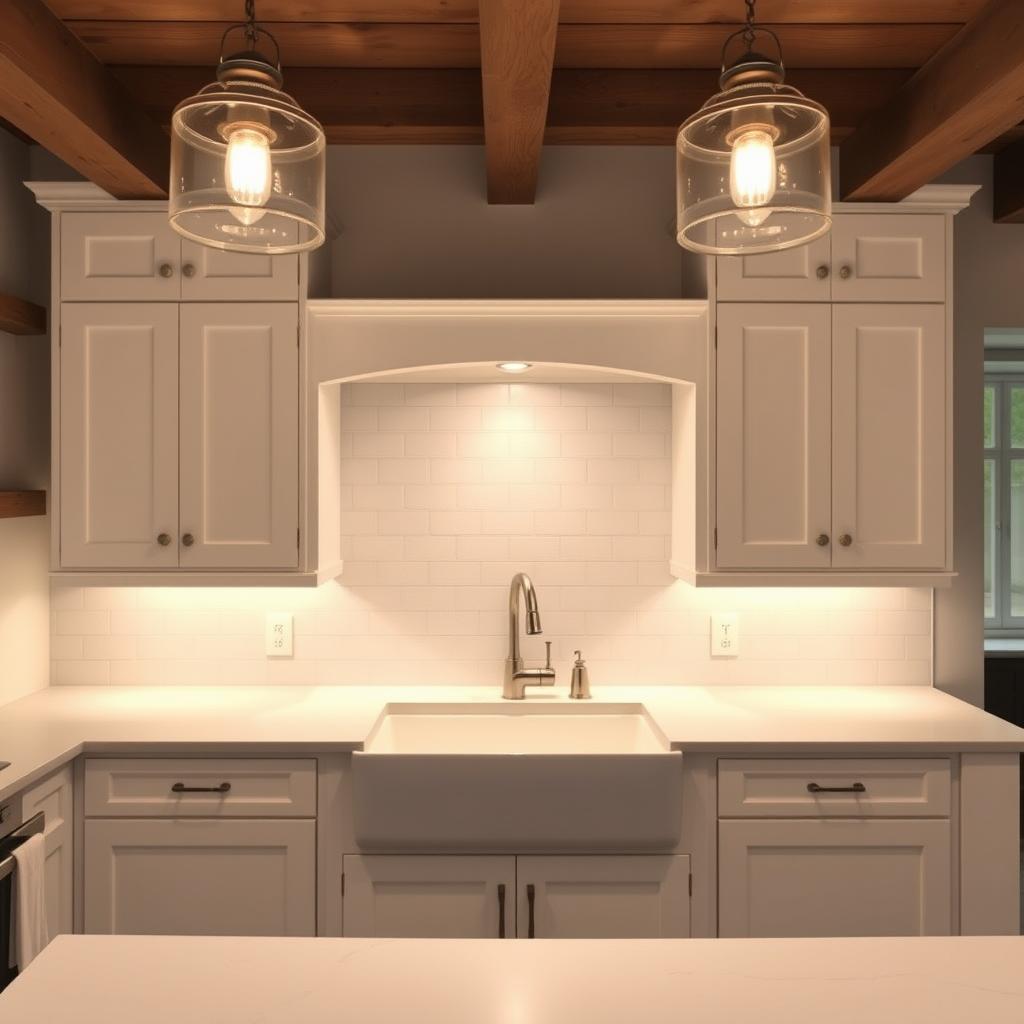
Classic details like deep sinks and sturdy cabinets define this beloved style. These features balance nostalgia with today’s needs, creating a space that’s both inviting and efficient.
Farmhouse Sinks: Classic and Practical
An apron-front sink is a hallmark of this look. Porcelain models, like those from Oak Barrel Cabinetry, offer timeless appeal. They’re deeper than integrated sinks, making them ideal for large pots or family meals.
Designers like Jeannot Vilarando pair these sinks with sleek faucets for contrast. The result? A focal point that’s as functional as it is charming.
Shaker-Style Cabinets for Timeless Appeal
Simple lines and sturdy construction make Shaker cabinets a go-to choice. Sarah Adnan’s green lower cabinets with wood-tone uppers show how color adds personality. For a bold twist, Windmill Cabinets uses black-and-white contrasts.
Modern hardware updates the look. Brass pulls or matte knobs complement the clean lines. Meta Coleman’s skirt alternatives—like beadboard panels—offer another way to customize.
Whether you prefer blonde oak or painted finishes, these elements shape a kitchen design that feels fresh yet familiar. The right mix of materials ensures durability and style.
Choosing the Perfect Color Palette
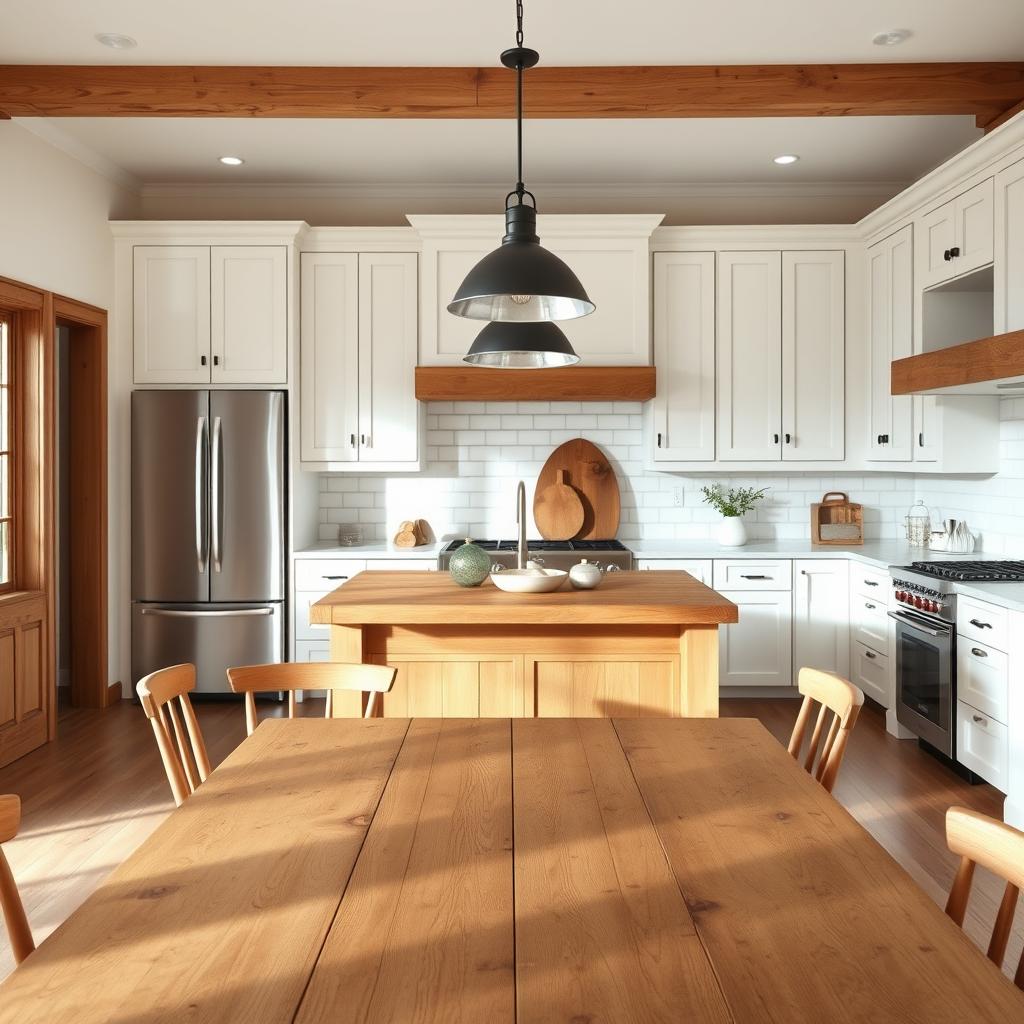
Color sets the mood in any space, and farmhouse designs thrive on thoughtful palettes. Whether you prefer soft neutrals or dramatic contrasts, the right hues create harmony. Designers like Caroline Brackett prove even navy cabinetry can feel inviting with brass accents.
Neutral Tones with Warm Wood Accents
Benjamin Moore’s Antique Pewter cabinets paired with oak beams strike a perfect balance. White walls and wood tones, as seen in Courtenay Hartford’s projects, add depth. Copper fixtures or gray stains, like those from Farrow & Ball, elevate the look.
Lindsey Black’s monochromatic wallpaper approach keeps spaces airy yet grounded. The key? Let wood textures shine against muted backdrops.
Bold Contrasts: Black and White Combinations
Windmill Cabinets’ high-contrast designs showcase matte black cabinets with mid-tone counters. For drama, pair crisp whites with ebony hardware. Erin Napier’s work highlights how stark palettes feel cozy when layered with raw materials.
From Lindsey Black’s geometric backsplashes to Laura Hodges’ checkerboard floors, contrast adds energy. The result? A space that’s timeless yet fresh.
Open Shelving for a Spacious Feel
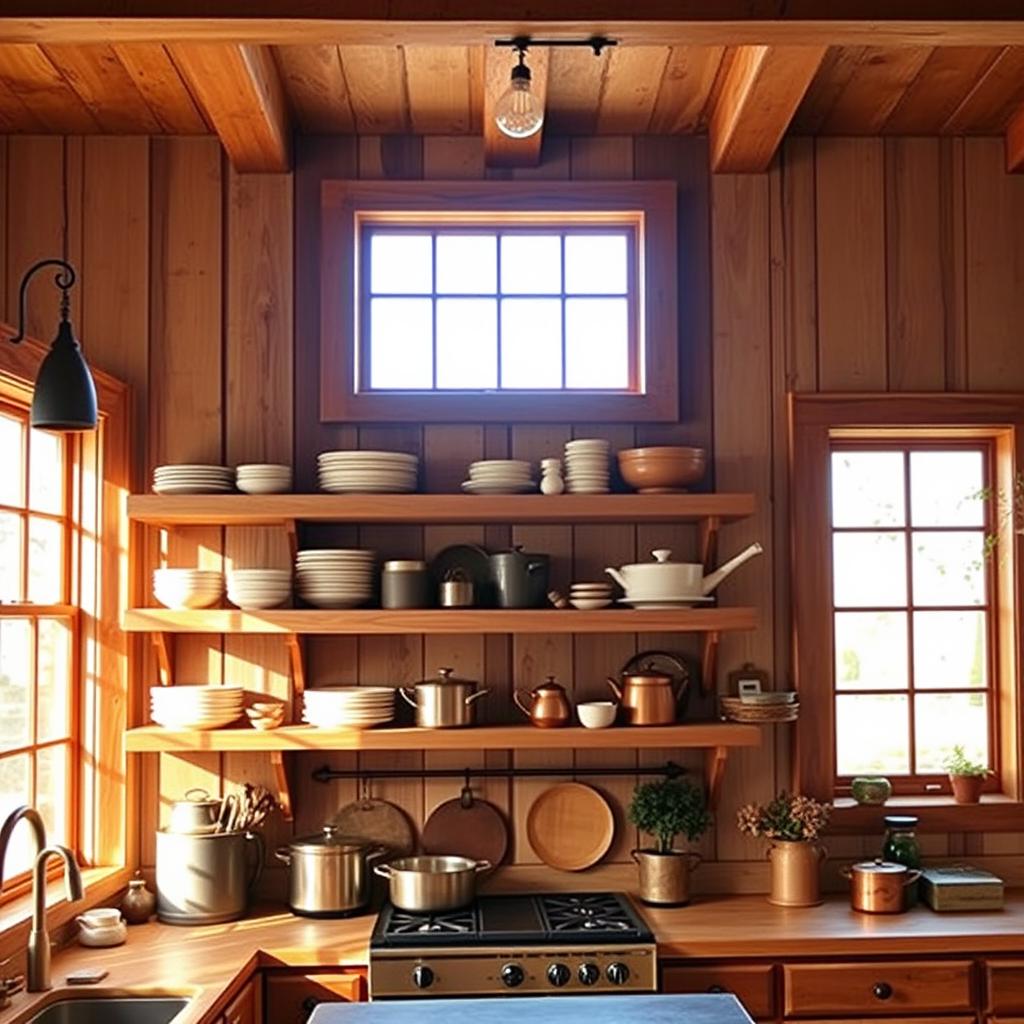
Replacing upper cabinets with shelves creates visual flow and personality. This approach lets you showcase elements like hand-thrown pottery or heirloom dishes while keeping essentials within reach. Designers like Leanne Ford use pegboard systems to blend storage with artful displays.
Materials to Consider: Reclaimed Wood vs. Painted Finishes
Reclaimed wood shelves, like Pfeffer Torode’s oak islands, add warmth and history. For a crisp look, painted finishes in muted tones pair well with shiplap backsplashes. Moisture-resistant options, such as sealed cedar, ensure durability in busy spaces.
Styling Tips for Functional Displays
Layer practicality with charm by grouping wood cutting boards and woven baskets. Dunbar Road Design’s plate walls prove even everyday items can be art. For curated accents, Ashley Gilbreath’s built-in antique displays mix vintage scales with fresh herbs.
Keep lower shelves for daily-use items and higher ones for decor. This balance ensures your open shelving stays both beautiful and useful.
Statement Lighting in a Modern Farmhouse Kitchen
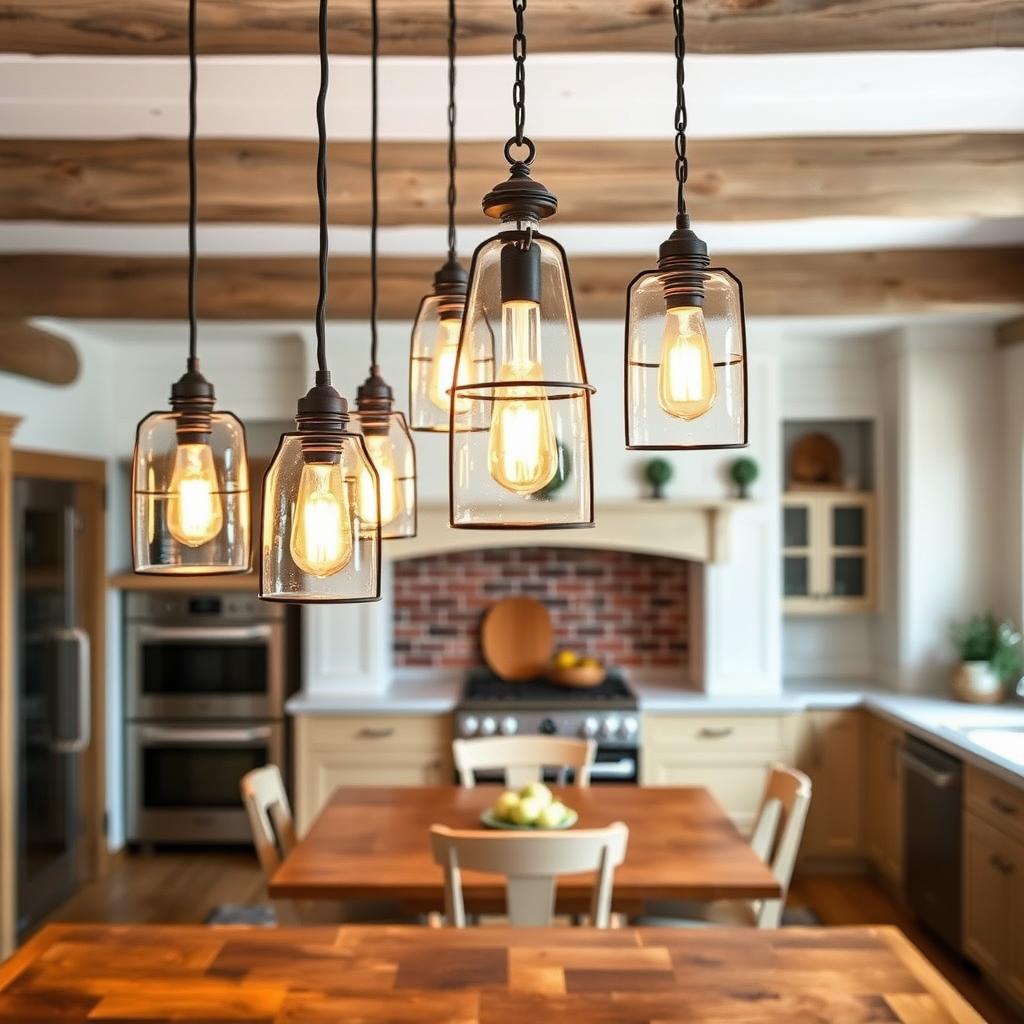
Lighting transforms a room from ordinary to extraordinary with just a flick of a switch. The right fixtures blend warmth with personality, becoming the focal point of your space. Whether you prefer rugged industrial pendants or delicate vintage chandeliers, each choice tells a story.
Industrial Pendant Lights
Raw metals and bold shapes define this look. Suzanne Kasler’s gold-accented pendant lights add a touch of glam above islands, while beehive-shaped glass fixtures diffuse soft, inviting glows. For balance, pair them with warm wood tones or patterned tile backsplashes.
Scale matters. Marie Flanigan’s reclaimed beam installations prove oversized lights anchor a room without overwhelming it. Keep fixtures 30–36 inches above countertops for both function and flair.
Vintage-Inspired Chandeliers
Crystal droplets or wrought iron designs evoke timeless charm. Lindsey Black’s European-inspired scullery lighting mixes crystal with matte black finishes for contrast. These pieces shine brightest in dining nooks or over sinks.
For a cohesive design, layer chandeliers with recessed lighting. The result? A layered glow that’s as practical as it is picturesque.
Incorporating Natural Wood Tones

Natural wood tones bring warmth and texture to any space, creating an inviting atmosphere. Designers like Laura Hodges use stained wood tones to add richness without overpowering a room. Whether through ceiling beams or floating shelves, these elements make a design feel grounded and intentional.
Ceiling Beams and Floating Shelves
Exposed beams instantly elevate a room’s character. Sheldon Harte’s textured wood ceiling pairs perfectly with white shiplap walls. For a lighter touch, Windmill Cabinets uses knotty maple for floating shelves—durable and full of natural variation.
Installation matters. Beams should complement existing architecture, not compete with it. Jeremiah Brent’s multi-wood kitchen proves how varied stains can coexist when balanced with neutral walls.
Mixed Wood Finishes for Depth
Layering different stains adds dimension. Try Allison Willson’s approach: rubble-finished limestone walls with oak cabinetry. The contrast between rough and smooth accents creates visual interest.
For cohesion, pick one dominant tone. Laura Hodges often uses walnut islands with lighter perimeter cabinets. This strategy keeps the farmhouse aesthetic feeling curated, not chaotic.
Remember: wood’s natural variations are its strength. Let grain patterns and knots become part of your design story.
The Charm of a Farmhouse Kitchen Island
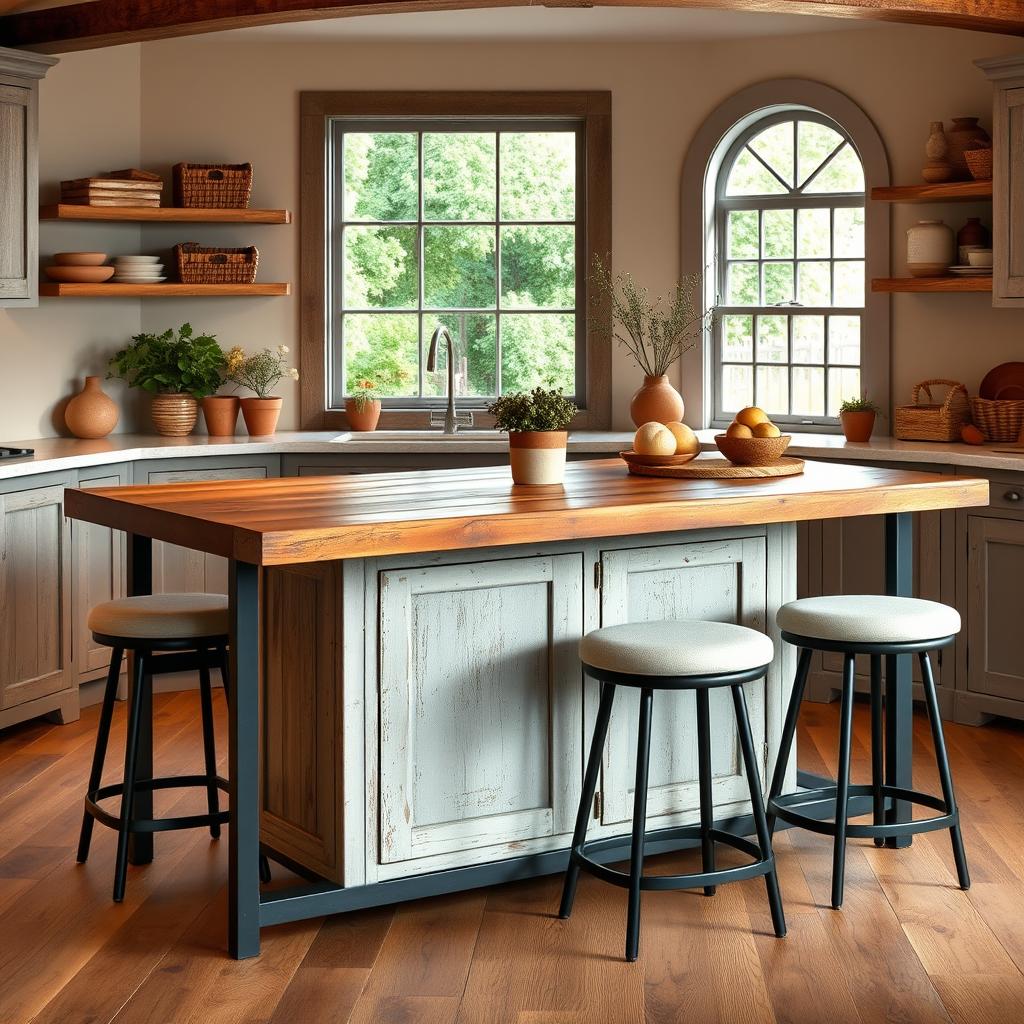
Islands serve as the heart of the home, blending style and practicality. Whether used for meal prep or casual dining, they anchor the space while adding rustic charm. Designers like Leah Ashley prove even vintage table islands can feel fresh with the right accents.
Butcher Block vs. Painted Islands
Butcher block islands offer warmth but need regular oiling to prevent stains. Maggie Griffin’s antique pewter island shows how painted finishes resist wear while adding contrast. Birch Point Homes uses sealed cedar for durability in high-traffic areas.
For a balanced design, pair wood tones with matte hardware. Leah Ashley’s reclaimed oak piece proves texture elevates functionality. Both options suit busy family life—choose based on your maintenance preference.
Adding Seating for a Gathering Space
Pfeffer Torode’s Windsor stools demonstrate how seating transforms islands into social hubs. Keep counter overhangs 12–15 inches deep for comfort. For taller designs, like those from Birch Point Homes, opt for adjustable barstools.
Layer woven placemats or vintage trays to define the family dining zone. The right mix of materials ensures your kitchen island stays inviting and practical for years.
Bringing It All Together: Your Dream Modern Farmhouse Kitchen
Creating a cohesive farmhouse kitchen blends rustic charm with smart functionality. Start by pairing sleek appliances with natural textures—think stainless steel against reclaimed wood. Courtenay Hartford’s timeless approach proves balance is key.
For smaller spaces, Rita Chan’s antique shelf trick adds character without clutter. Larger areas can handle bold moves like Amanda Jacobs’ sage green cabinets. Always consider upkeep—sealed surfaces and durable finishes keep mixed materials looking fresh.
Here’s your quick checklist:
– Mix warm woods with crisp whites
– Layer lighting for ambiance
– Choose one standout feature (like Cecilia Casagrande’s sunny yellow island)
– Keep storage practical yet pretty
Your home deserves a style that feels both lived-in and intentional. Whether you’re renovating or refreshing, these kitchen ideas ensure a space that’s as functional as it is inviting.
If you want to read more article,please click here.
If you want to know more,then click here.
Leave a Reply